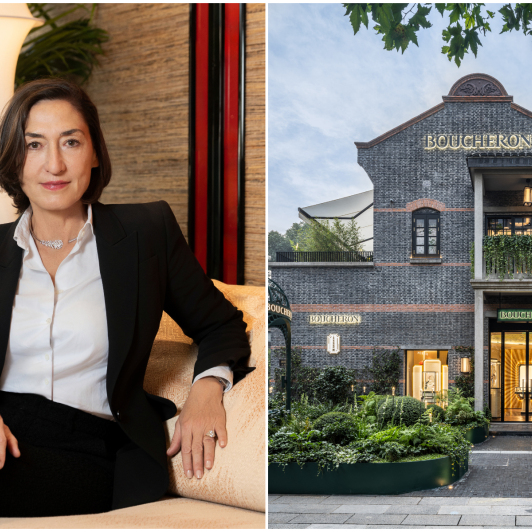Jean-Christophe Babin, the global CEO of BVLGARI, is arguably one of the most prominent luxury brand CEOs on social media. Active on Instagram with 194,000 followers, he frequently shares updates about Bvlgari’s global brand activities, often sparking discussions, particularly regarding brand ambassadors. His personal account’s engaging content is frequently referenced and shared by young Chinese netizens.
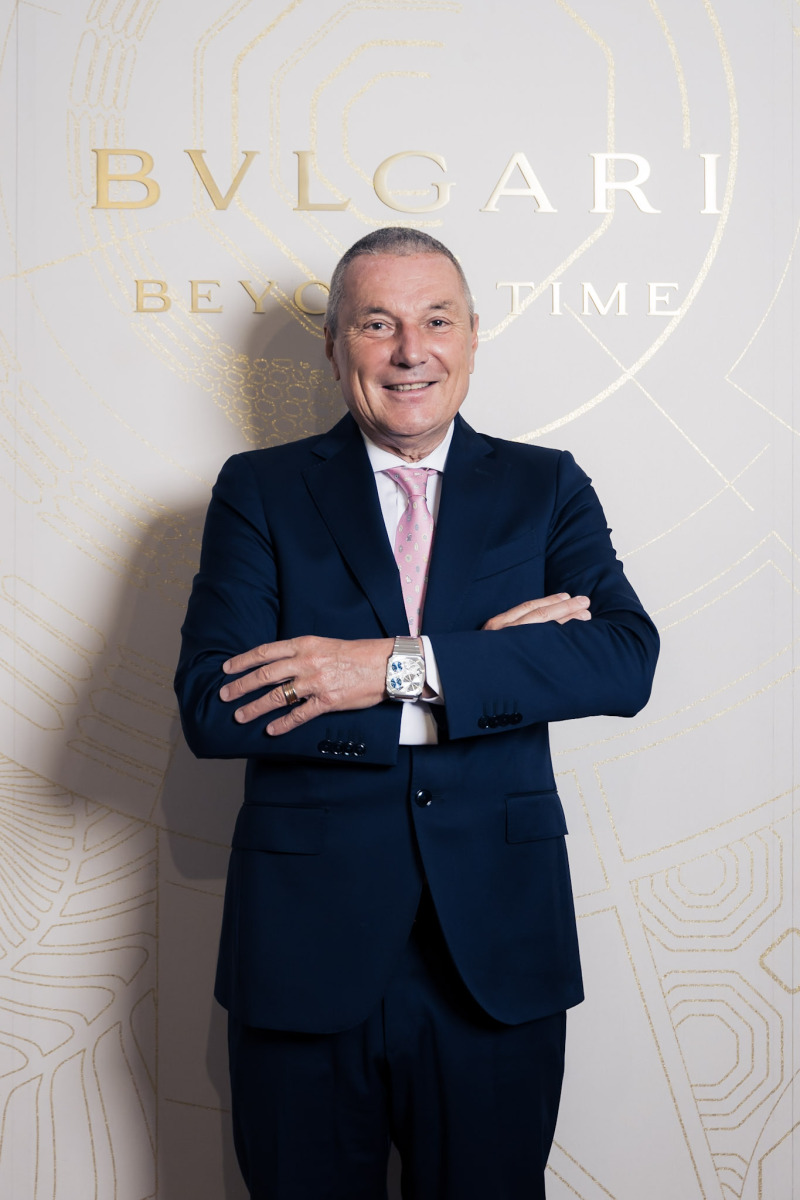
Jean-Christophe Babin, Bvlgari CEO since 2013, marking his 11th year

Babin’s Instagram account with 194,000 followers
Last week, Bvlgari’s significant exhibition, “BVLGARI Serpenti Factory: Eternal Metamorphosis,” made its final stop in Beijing. Babin documented his journey on Instagram, starting from his flight, covering the exhibition, store visits, and even his morning runs and swims along Liangma River, immersing himself in Beijing’s summer.
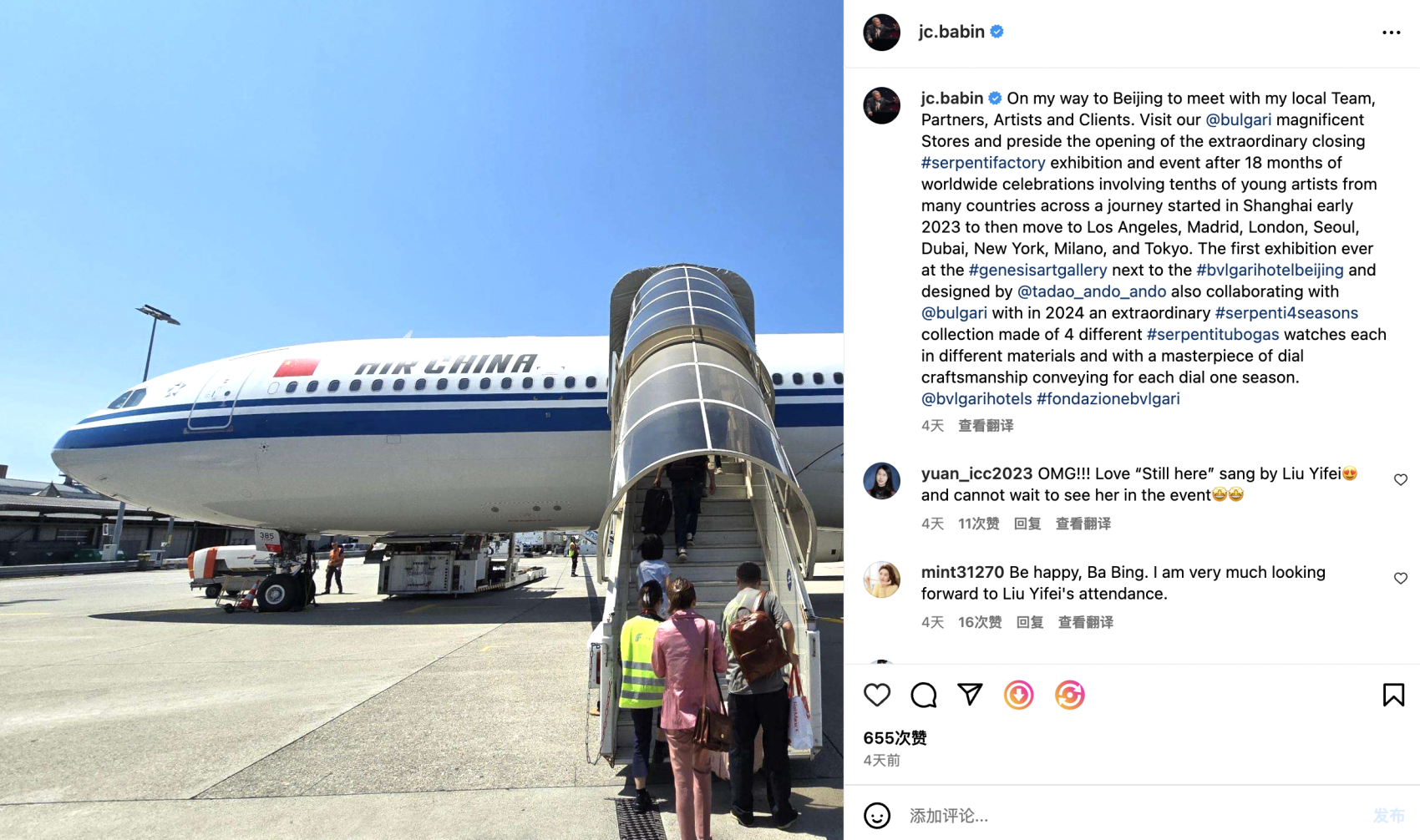
Babin told Luxe.com that he traveled without a visa, benefiting from the “144-hour visa-free transit” policy, making his visit very convenient.
Babin is an old friend of Luxe.com, having been interviewed twice before in 2018 and 2020. During the opening of the Serpenti exhibition in Beijing, he spoke with Luxe.com again, discussing the brand’s recent changes, category strategies, consumer insights, store strategies, and art support.
Below are some highlights:
- The luxury industry has faced far more challenging times than now. Growth is achievable but more difficult.
- 80% of Bvlgari hotel guests are new customers, providing a strong source for high jewelry clients.
- Stores that are too dense or too large are a waste. For most cities, a 250-square-meter store is suitable for Bvlgari.
- In tough times, Bvlgari should realistically showcase the brand “behind the scenes” to provide customers with a sense of security.
- Bvlgari’s competitors are not just Cartier but could also be destinations like the Maldives.
The “BVLGARI Serpenti Factory: Eternal Metamorphosis” Art Exhibition in Beijing is the final and largest stop of this series of exhibitions. It showcases representative works from various historical stages of Bvlgari’s Serpenti series, as well as artworks by multiple artists centered on the “serpent” theme.
A successful brand exhibition is multidimensional. This exhibition reflects on the brand’s cultural history, classic collections, and collaborations with contemporary artists, exploring technological innovations. Through this exhibition, one can glimpse how the brand’s leaders understand the brand and strategize.
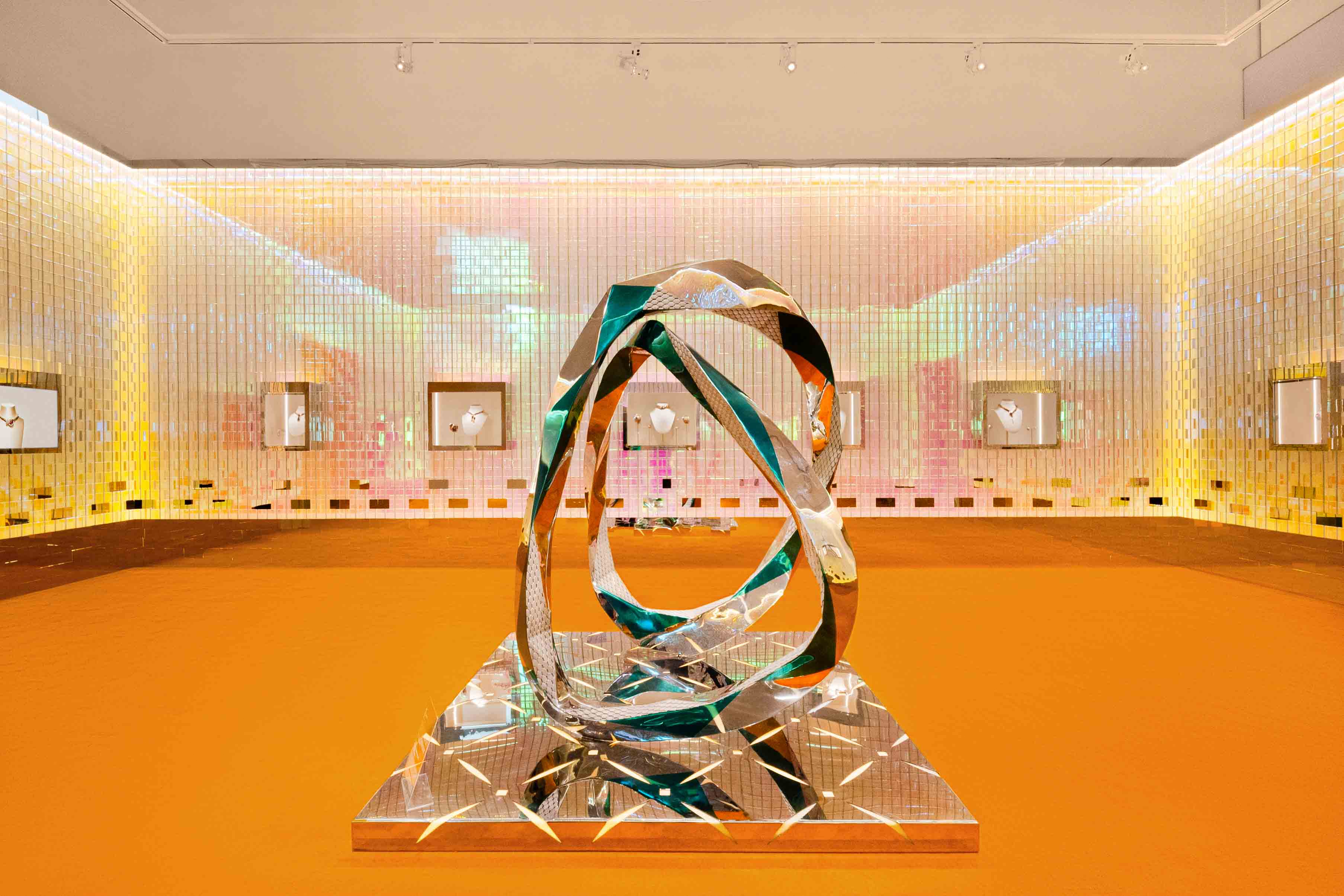
Exhibits at the Serpenti Exhibition in Beijing – Zhou Li’s artwork “Metamorphosis – Life as a Ring.”
In his opening speech, Jean-Christophe Babin stated: “From ancient times to the present, the serpent totem has been etched into human civilization with bold creativity and profound meanings, providing endless inspiration for artistic and cultural creations.”
The “Bvlgari Serpenti Factory: Eternal Metamorphosis” exhibition traveled from Shanghai and returns to China, concluding the “Serpenti Factory” art project in culturally rich Beijing. The exhibition in Beijing brings together significant artworks from the global tour, hoping to share the transformative spirit represented by the serpent with more people in China.”
Interview Highlights
Post-Pandemic, Desire for Bvlgari Has Increased
Luxe.co: In our last interview, you mentioned that in 2020, Bvlgari ranked second globally in jewelry, tenth in watches, and fifth in perfumes. Has there been any change in these rankings over the past four years?
Jean-Christophe Babin: There hasn’t been any change. Like other brands, we were impacted by the COVID-19 pandemic. However, we rebounded post-pandemic and probably had the fastest growth in the industry last year.
Our market share increased in the first half of this year, but the rankings likely remained unchanged. Post-pandemic, the desirability of the Bvlgari brand has risen.
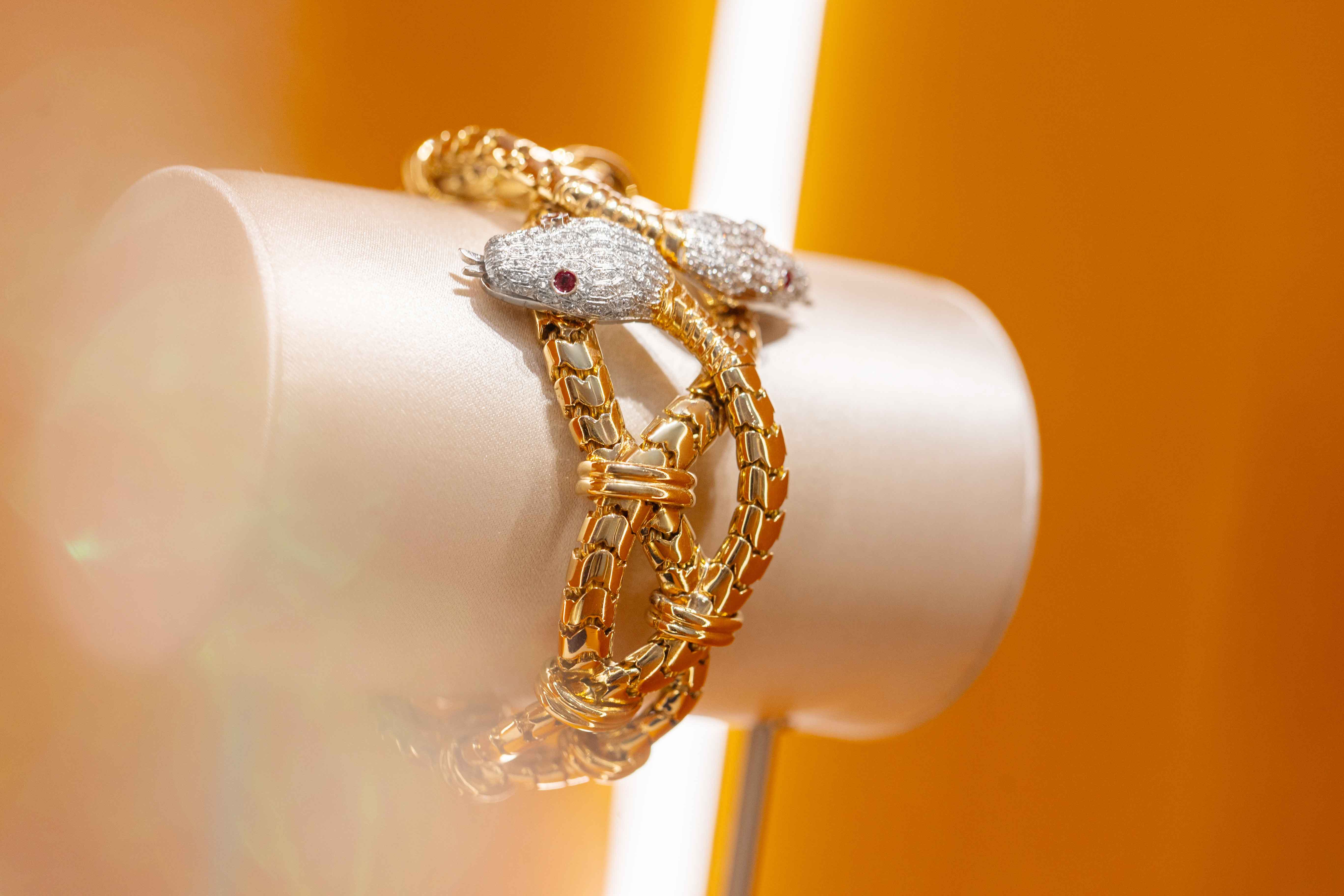
Exhibits at the Serpenti Exhibition in Beijing – Bvlgari Serpenti Vintage Collection.
We’ve upgraded our stores, matured our communication strategies, and strengthened our collaborations with brand ambassadors. Our product offerings have also expanded, including the latest Serpenti high jewelry series and the more everyday Viper series.

Bvlgari Serpenti High Jewelry Necklace.

Bvlgari Serpenti Viper Jewelry.
Bvlgari hotels have also enhanced brand desirability. Hotels offer an immersive brand experience. While customers may not spend long in a store, they can stay one or two days in a hotel, experiencing the brand from multiple perspectives.
Return to Normalcy in Luxury Consumption Post-2024
Luxe.co: Do you think the current luxury industry is facing significant challenges?
Jean-Christophe Babin: No, we have faced much tougher times. The 2008 global financial crisis was extremely challenging, particularly for Western countries, while Asia was less affected.
The first half of 2023 was exceptionally good for luxury brands, including Bvlgari. The pandemic led to reduced consumption and wealth accumulation, resulting in “revenge buying” in early 2023. However, people spent their excess money last year, and luxury consumption is now returning to normalcy.

Serpenti Exhibition in Beijing – Serpenti Tubogas Special Edition Watch by Tadao Ando.
Currently, many feel a sense of uncertainty about the world. However, uncertainty has always existed in human history, and we need to coexist with it.
Post-pandemic, many countries raised interest rates, and supply exceeded demand, creating economic tension. Yet, GDP growth continues, albeit slower than before the pandemic. This indicates global wealth is increasing, though at a slower pace.
Given these circumstances, luxury brands need to be more creative, agile, substantial, and authentic than ever. The desirability of the Bvlgari brand needs to continue rising to drive sales. It’s more challenging to sell luxury today than six years ago, but it’s still possible.
On the other hand, the external environment has not restricted us. We also saw growth in the first half of this year—growth is achievable but more difficult.
Dependence on Repeat Purchases is Not Feasible
Luxe.co: How frequently do people buy jewelry?
Jean-Christophe Babin: Jewelry and fashion are quite different. In fashion, new trends prompt frequent repeat purchases, and fashion weeks stimulate demand. In jewelry and watches, we don’t have “fashion weeks.” We host brand events, but they’re not systematic industry events.
Moreover, jewelry is more expensive than fashion. People don’t buy jewelry as frequently, maybe every few months or even years. Our products are timeless, which is an advantage over fashion. However, purchases are occasional, a disadvantage compared to fashion. We need to balance this paradox.
We must continuously attract new customers because many don’t purchase every year. We can’t rely on repeat purchases alone; we need both repeat and new customers. Hence, we have various initiatives to attract new clients.
Bvlgari is a Broad-Range “Informal” Jewelry Brand
Luxe.co: Among Bvlgari’s various categories, what is the brand’s customer acquisition strategy?
Jean-Christophe Babin: Our brand ambassadors are very strong and have helped us gain many young customers, such as Zendaya in the United States, and Liu Yifei and Leo Wu in the Chinese Mainland—both of whom attended the exhibition opening event. Bvlgari’s jewelry products not only attract high jewelry enthusiasts but also offer entry-level products priced suitably for young people.
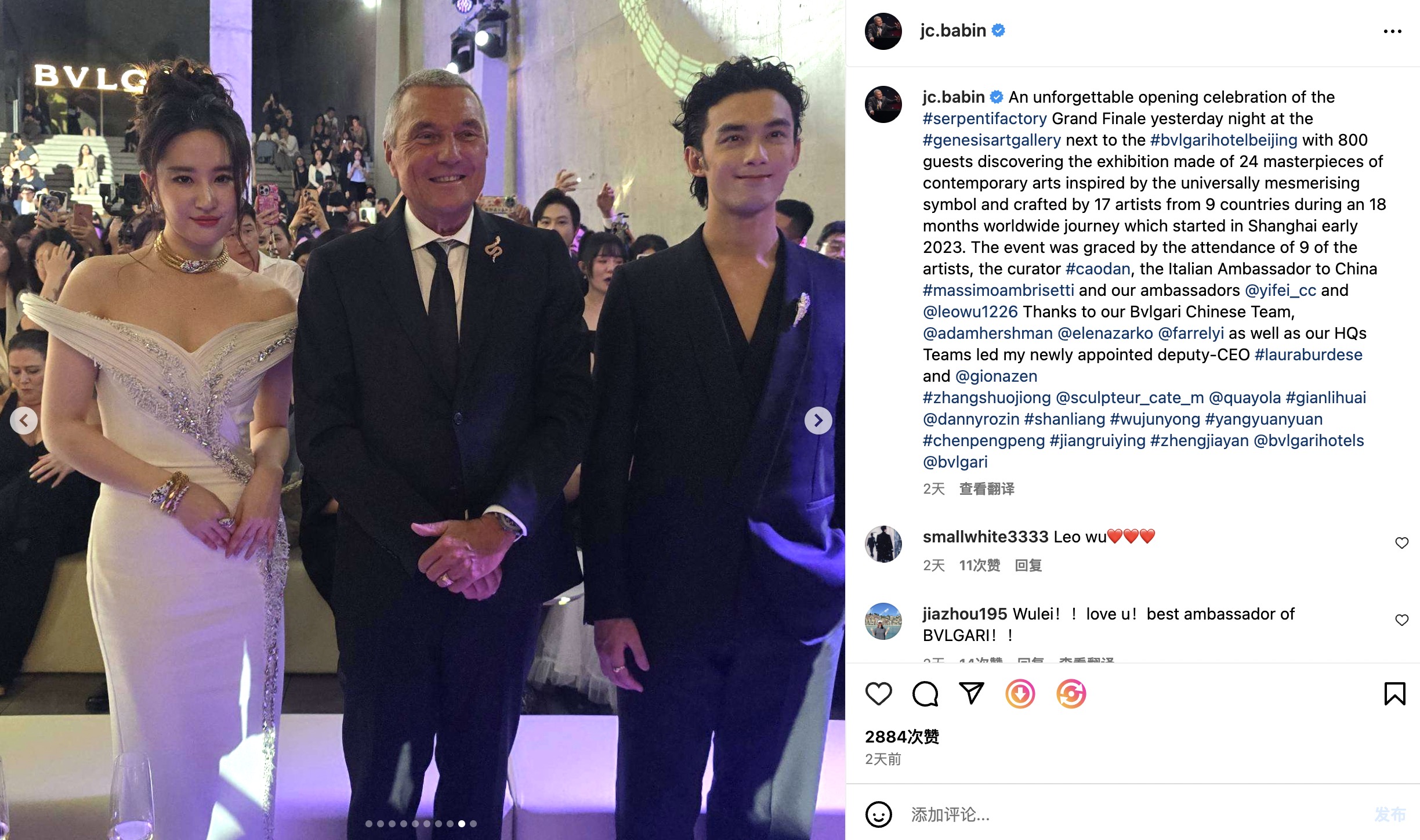
Babin with brand ambassadors Liu Yifei and Leo Wu at the Serpenti Beijing exhibition opening.
Compared to many more formal jewelry brands, Bvlgari is a relatively “informal” brand. This characteristic also attracts many similarly informal young customers. Our exhibition activities are very sophisticated and modern, fitting the lifestyle of young people.
Although we do a lot to attract young people, we never forget that the majority of Bvlgari’s customers are not in their twenties, but rather in their thirties and forties. Therefore, we must strive to balance this, not only with attention but also with product categories.
One reason we make fragrance products is to attract younger customers—fragrance products are more affordable for young people. When you buy a Bvlgari fragrance, you enter the world of Bvlgari.
Small leather goods are also a very strong category for us. Young people can start with purchasing Serpenti wallets and other small leather goods. Our eyewear and sunglasses categories also perform well.

Bvlgari attracts both young people and wealthier, more mature customers. The fragrance, small leather goods, eyewear, and sunglasses categories provide customers for our core business—regular jewelry and watches. Our highest-end business—high jewelry—partially draws customers from our hotel business.
Each category has its precise role. We do not need to expand into new categories; our current lineup is well-balanced.
80% of Bvlgari Hotel Guests Are New Customers
Luxe.co: What is the profile of Bvlgari hotel guests?
Jean-Christophe Babin: Bvlgari hotel guests are not business executives on company expenses—no company will reimburse an employee for a €2,000 per night hotel, and I wouldn’t do it myself. Bvlgari hotel guests are individuals who can afford suites costing €3,000 to €30,000 per night, such as entrepreneurs. These people are capable of becoming high jewelry buyers.

Suite at Bvlgari Hotel Beijing.
Globally, we currently have nine Bvlgari hotels in operation, three under construction, and three more prepared to open, totaling around 15 Bvlgari hotels. This helps us effectively establish a global customer network.
80% of Bvlgari hotel guests are new customers. Through systematic CRM operations, we guide these guests into Bvlgari’s high jewelry world.
Chinese Customers Are More Cautious with Luxury Spending
Luxe.co: In April, LVMH CFO Jean-Jacques Guiony mentioned that Chinese customers are currently the most unpredictable. What are your thoughts on this change?
Jean-Christophe Babin: Last September, we held a high jewelry event in Shanghai. Compared to previous years, aside from global events, the Chinese Mainland’s VIC events have become the number one VIC event globally. We will also do our best to ensure the success of this year’s VIC event.
However, many VICs prefer attending overseas events, such as in Rome, rather than in Shanghai. The most stable part of the Chinese Mainland market today is the VIC clientele, which is true globally. Local VICs are always the most resilient.
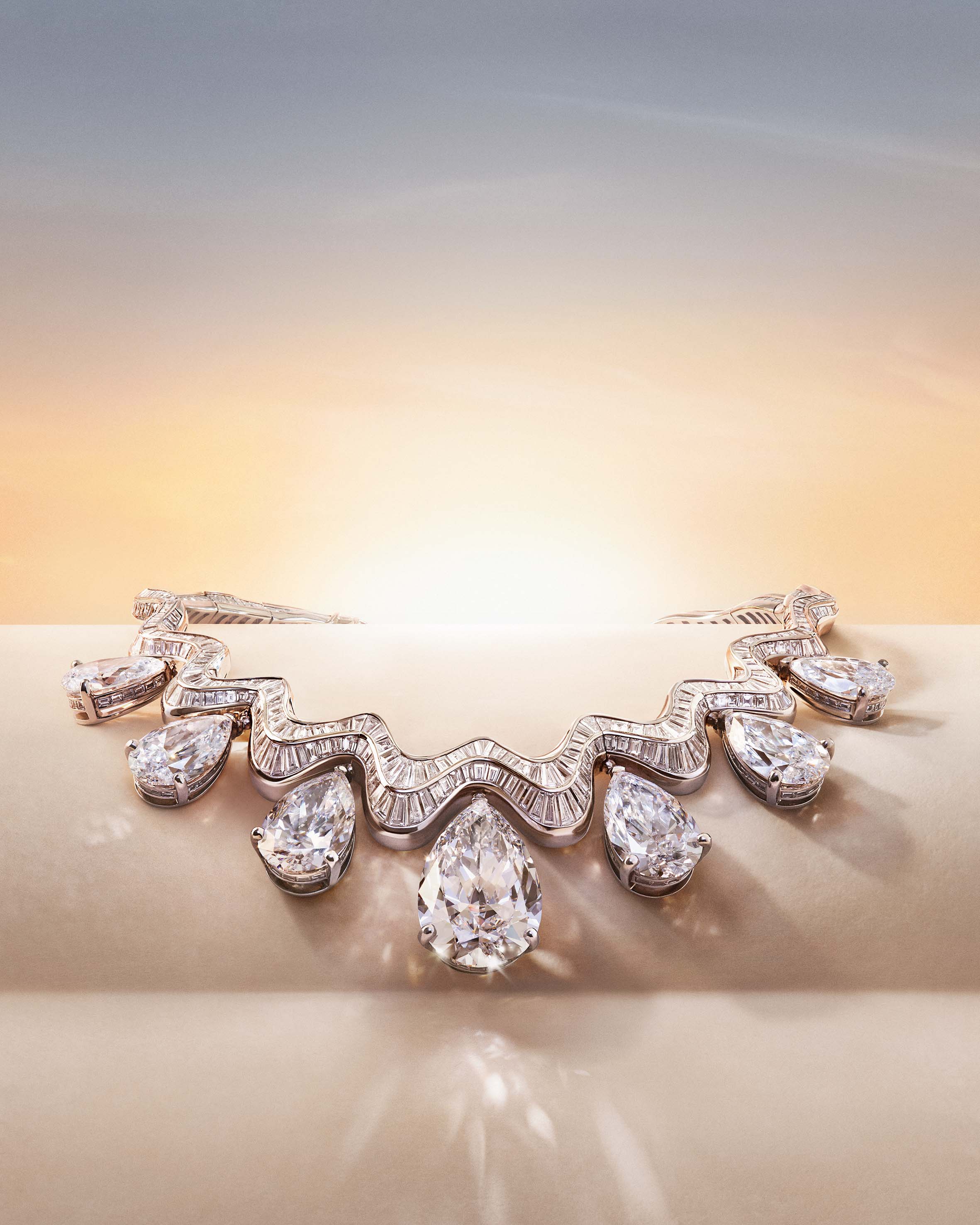
Exhibit at the Serpenti Exhibition in Beijing – Bvlgari AETERNA High Jewelry Serpenti Necklace.
VICs are crucial; high net worth VIC clients are more resilient in luxury spending. But brands cannot rely solely on existing VICs, as their numbers are limited, and luxury jewelry and watch purchases are infrequent. The core challenge remains making the brand more attractive to new customers.
Unlike the West, which has experienced long-term crises for the past 25 years, the current generation in the Chinese Mainland is encountering an economic downturn for the first time. Although not severe, it’s a first-time experience for many, leading to cautious spending due to uncertainty about the future.
In Europe and America, the 2008 financial crisis was severe, followed by periodic crises every few years. Europeans and Americans are now familiar with these cycles. While not indifferent, they are accustomed to such occurrences. In contrast, the Chinese Mainland is experiencing a sudden shift after decades of rapid growth, causing confusion and cautious spending.
European families tend to focus more on spending for themselves, while families in the Chinese Mainland place a strong emphasis on leaving an inheritance. This cultural difference impacts spending behavior.
Luxury Brands Need to Be More Substantial and Realistically Showcase “Backstage”
Luxe.co: In the current uncertain environment, what attitude do you think luxury brands should take towards their customers?
Jean-Christophe Babin: I believe we need to be more substantial. People now feel confused and uncertain about the future. We need to reassure them: Bvlgari offers classic products that symbolize eternity. This not only refers to our jewelry being made of gold and diamonds but also to the timeless design of our products. Customers can wear them forever and even resell them.
Jewelry and watches are different from fashion products—if you buy a bag this season, you might not be able to use it next season because trends change—but Bvlgari is not a fashion product. For example, the Bvlgari B.ZERO 1 ring, born in 1999, remains timeless even after nearly 30 years.
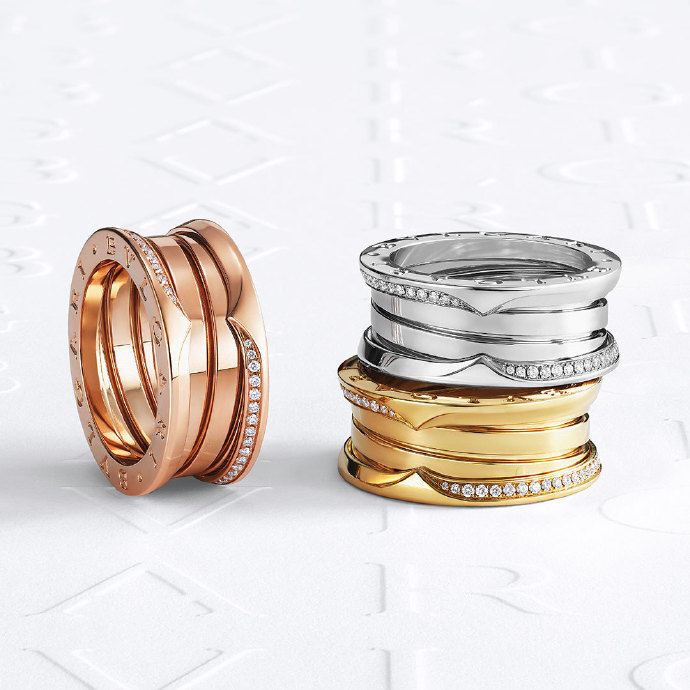
Bvlgari B.ZERO 1 ring
Compared to the past, we need to emphasize that Bvlgari is an authentic brand, with exquisite craftsmanship, made from excellent materials, and provides comprehensive after-sales service. If there is a problem with a watch, we will efficiently help you solve it and will not disappoint our customers.
We need to show customers the “backstage” of the brand, making them feel secure and reassured. The Bvlgari brand is sincere, ethical, transparent, caring, professional, and everlasting—many people may forget this, but the jewelry you wear can transcend time. You can pass your jewelry to your daughter, and she will not feel it is outdated.
We do not need to take an aggressive attitude towards customers; we need to be more substantial and showcase the true side of the brand. For example, two years ago, we released the film “Inside the Dream,” revealing the secrets and charm behind the creation of jewelry and showing the entire creation process.
Recently, we released a documentary on Amazon Prime Video, “AN EMPEROR’S JEWEL – THE MAKING OF THE BVLGARI HOTEL ROMA,” which tells the story of the construction and opening of the Bvlgari Hotel in Rome—this is also a demonstration of Bvlgari’s craftsmanship.
Now, we demonstrate the Bvlgari brand more through real things—as Americans would say, we are a “blue-chip”—a trustworthy, reliable, and eternal brand.

Poster of Bvlgari’s documentary “AN EMPEROR’S JEWEL”
It is important to showcase the “behind the scenes” of the brand. People do not buy superficial luxury goods. They want to buy products with stories, craftsmanship, heritage, ethics, and substantiality that make them feel reassured—even if they are a bit fearful of the future, why not buy a piece of jewelry?
A 250-Square-Meter Store Is Good Enough, 1,000 Square Meters Would Not Make Me Happy
Luxe.co: What are your observations on the current offline retail environment and store openings in China?
Jean-Christophe Babin: For Bvlgari, we must strike a balance; we can decline commercial real estate invitations. If we slice the cake too thin, it results in a “lose-lose” outcome for both the brand and the commercial entity—our productivity will decrease.
In Beijing and Shanghai, we have four or five stores because these cities have large markets. In some cities, in my opinion, one store is enough, but three real estate developers approach us, and we feel pressured. When you open a store in Beijing, they expect you to continue opening stores in other cities’ commercial projects—this is an issue.
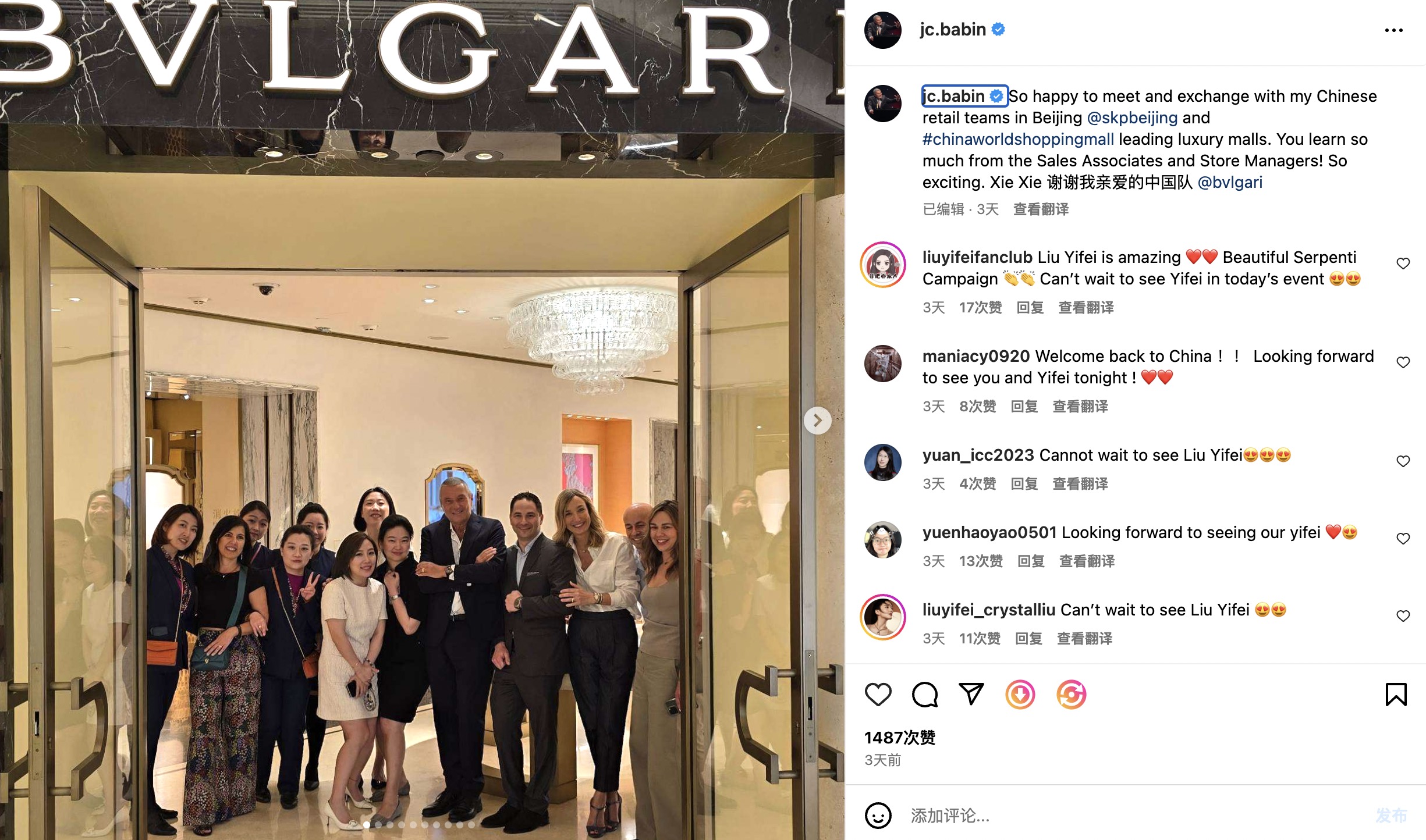
Babin touring stores in Beijing
Another issue is opening “big spaces.” There are more and more commercial entities, and the stores are getting bigger and bigger.
For Bvlgari, when I have a 1,500-square-meter store, I do not know how to utilize that space. In most cities, I think Bvlgari fits a 150-250 square meter store. If I have an extra 100 square meters, I can set up an experience area, which is also good for many cities. If it is 500 square meters, it becomes a waste, let alone 1,500 square meters.
But often, commercial entities propose spaces no smaller than 1,000 square meters. We are not necessarily interested—why pay for 1,000 square meters we do not need?
This “store expansion” situation is somewhat influenced by fashion brands. Fashion brands need fitting rooms; they need more space, but rings do not need that much space.
Some jewelry brands pretend to need large spaces, and I do not know why. Commercial entities are often misled by these jewelry brands into thinking that all brands need large spaces—but Bvlgari does not need that.
Flagship stores need large spaces, but we have only 20 flagship stores globally in 300 cities. For the other 280 cities, a 200+ square meter store is excellent; a 1,000 square meter store would not make us happy. But if you do not accept a 1,000 square meter store, you get “marginalized” because the mainstream in Chinese malls is now to open big stores.
Ultimately, I think this is still caused by an oversupply of commercial entities in various places.
Airport Retailing Is Not Necessarily Only for Saving Money
Luxe.com: What is your view on airport retailing?
Jean-Christophe Babin: Many people shop at airports not because of discounts or tax-free benefits, but because it is convenient.
If I need a shirt tonight to fly back to Europe, should I buy it at the airport today, or waste my Saturday afternoon going to Zurich? I certainly do not want to waste my afternoon going to Zurich; I want to spend time with my family on Saturday. So the airport is not necessarily a “saving” location (except for certain categories like liquor); it is a time-saving scenario.
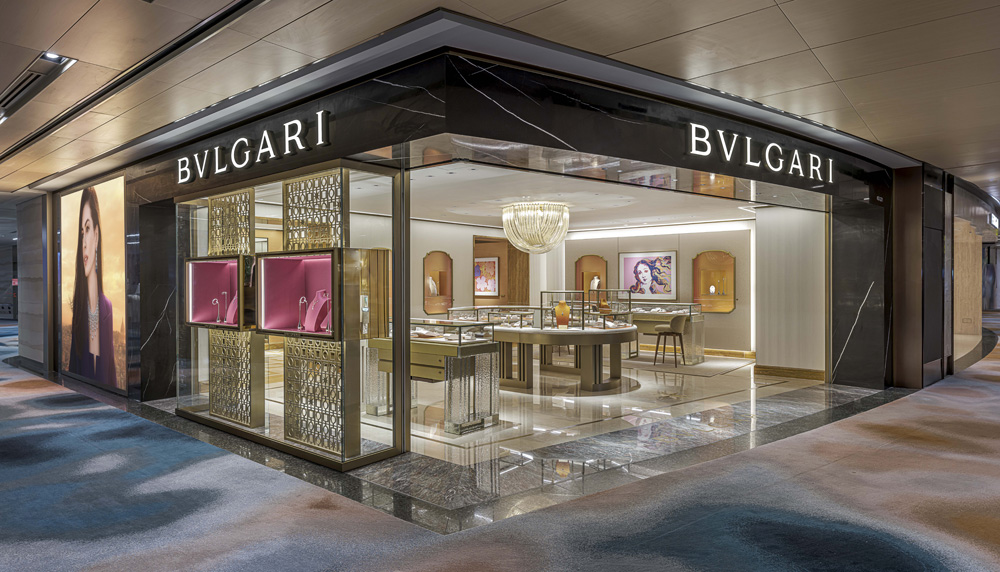
Bvlgari store at Changi Airport, Singapore
Bvlgari has always been a pioneer in luxury airport retailing, and we have achieved good results. Airports provide us with excellent locations and traffic. Due to security checks and waiting times, shopping at airport stores is time squeezed.
The last time I traveled, I went to an Italian brand’s airport store to buy a shirt. I knew my shirt size, paid for it immediately, and did not need to try it on. Not only me, but many people also do the same—buy what they need right away.
We have also opened some duty-paid stores at airports. This is also a good start.
Bvlgari’s Competitors Are Not Necessarily Cartier, But Could Be the Maldives
Luxe.co: How do you see the changes in industry competition today?
Jean-Christophe Babin: We must view competition broadly. Customers who don’t buy Bvlgari might not necessarily buy Cartier; they might use that money to go on a vacation to the Maldives. Today’s competition is not just traditional; it’s anywhere people can spend their discretionary funds.
Consumption fundamentally comes from people’s discretionary funds, and we must create the “most desirable experience.” Bvlgari competes not just with other jewelry and watch brands but with all desirable experiences. People might choose to spend a week in the Maldives, enjoying a spa, paired with good wine and food. This brings competition to luxury brands.
So, we created Bvlgari Hotels. Most luxury brands cannot offer or directly provide this experience.

Bvlgari Maldives Ranfushi Hotel, expected to open in 2025.
On the one hand, we can’t compete in just one field; we must rely on multiple categories. We’ve already achieved this, and we don’t need to enter more fields. As I mentioned, Bvlgari’s various categories already complement each other well.
On the other hand, we need to be more authentic in revealing our backstage, disclose more of “who we are.” Customers want to connect not just with products but also with the brand as a “person.”
We must work harder than ever to avoid hiding anything. Thus, we need managers who are willing to transparently reveal behind-the-scenes.
We are not afraid to showcase “behind the scenes” or to admit mistakes as long as we have plans to correct them. We hope managers will be less in the ivory tower and more close to customers.
Today, successful CEOs are often very close to the frontline, hands-on, and very transparent. But this is not yet built into every corporate culture; some prefer to hide in a “black box.” I believe good companies should be transparent and close to their customers, just like when people assess the character of friends.

Babin swimming in Liangma River, Beijing.
Bvlgari Was Born from Art and Gives Back to Art
Luxe.co: In March this year, the Bvlgari Foundation (Fondazione BVLGARI) was established in Rome, and the Serpenti exhibition also concluded its final stop in Beijing. What message does Bvlgari want to convey through a series of art support activities?
Jean-Christophe Babin: First, we want to enhance our social contribution. We are a brand born in the “Eternal City” of Rome, which has a very rich artistic and architectural heritage, and Bvlgari has benefited greatly from it. So we hope to enhance Rome’s artistic influence by restoring some artworks and ancient buildings.
Second, we want to lay a solid foundation for the future. Art was a crucial factor in our past success, and we also need to enhance the influence of art in the future to benefit from it in the future—this is also the reason for launching the Serpenti Factory project, to collaborate with young artists from around the world.
In 2017, we established the MAXXI BVLGARI PRIZE in Italy, allowing more young talents to step into the spotlight. They need exhibitions and collaboration platforms like this to showcase their talents.
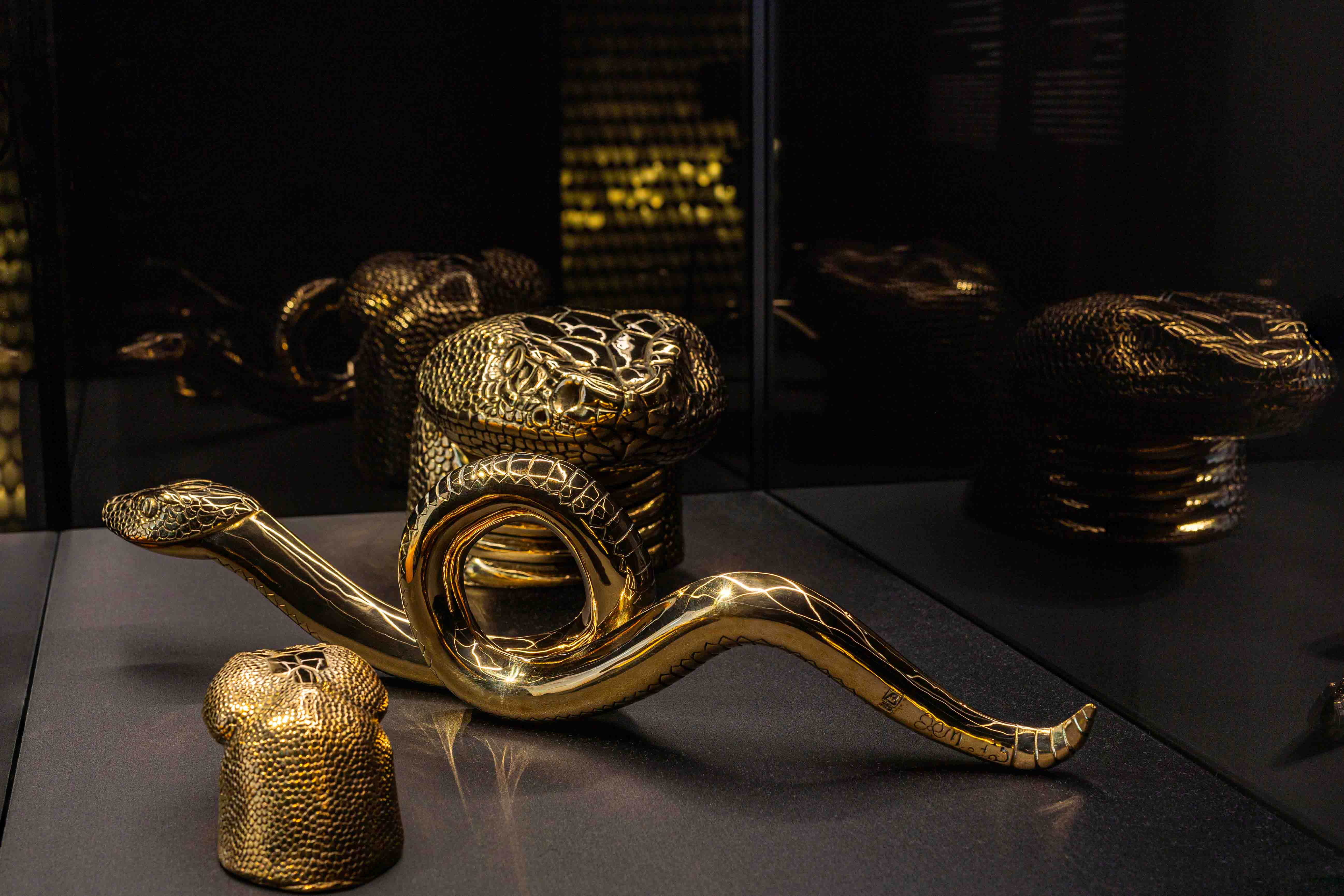
Exhibits at the Serpenti Exhibition in Beijing – Sculptor Cate M Mercier’s works “The Small and Big Python Head” and “The Mandarin.”
However, we do not require artists to create jewelry but to create art around core elements, such as Serpenti or the “Eight-Pointed Star”—the Eight-Pointed Star originated in Rome, symbolizing all roads leading to Rome.
Our support does not set any short-term goals. Some works in the exhibition may evolve into jewelry in the future, and some may not. Ultimately, it does not matter; what matters is that we are promoting and developing art—for example, this Serpenti exhibition. The serpent motif is a fascinating symbol in human society, from art to jewelry and watch products.
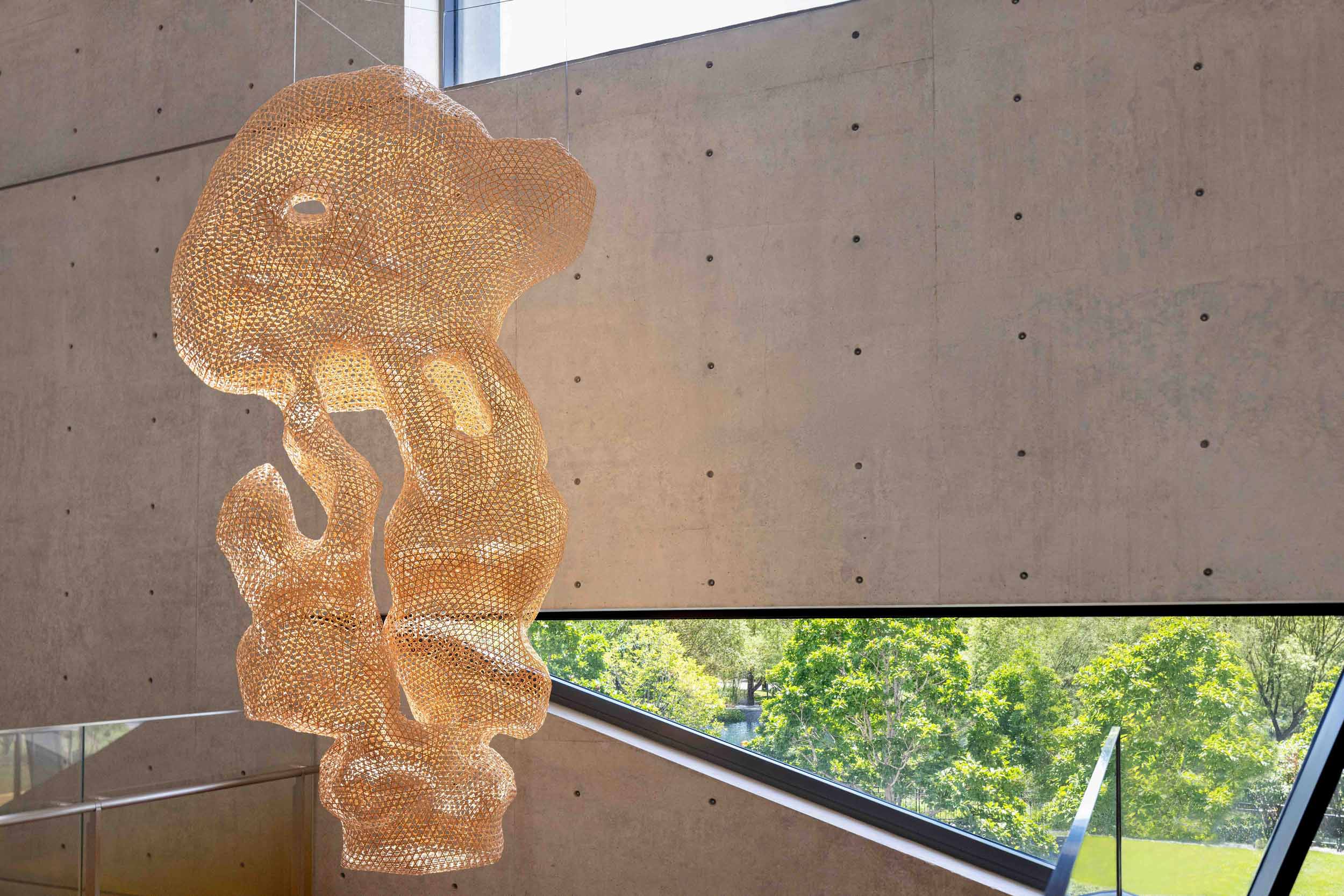
Exhibits at the Serpenti Exhibition in Beijing – Bamboo weaving heritage inheritor Qian Lihuai’s installation “Serpentine.”
“Serpenti: Form to Eternity” Art Exhibition – Beijing Stop
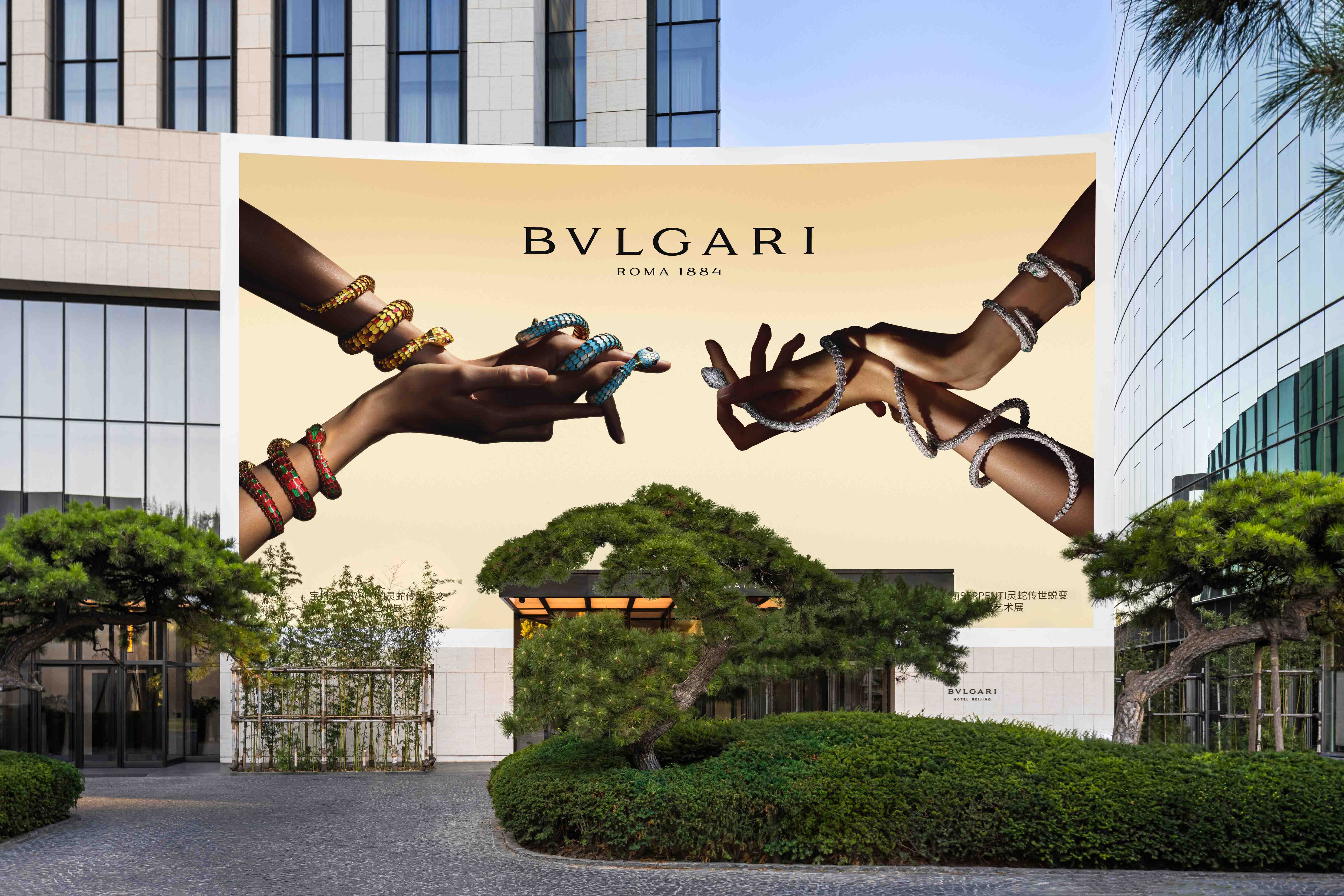
The “Bvlgari Serpenti Factory: Eternal Metamorphosis” Art Exhibition Beijing stop is held at the Beijing Genesis Art Gallery from July 19 to August 18. The public can make reservations through the official mini-program “Explore Bvlgari” to visit the exhibition for free.
To celebrate the 75th anniversary of the Serpenti series, Bvlgari launched the “Serpenti Factory” art project in 2023, which has traveled to cities including London, Madrid, Shanghai, Seoul, New York, Los Angeles, Dubai, Milan, and Tokyo over the past two years.

Exhibits at the Serpenti Exhibition in Beijing – Serpenti High Jewelry Collection “Serpenti Floral Embrace Choker.”
| Image Credit: Provided by Bvlgari Brand; Bvlgari Official Social Media Accounts; CEO’s Instagram Account
| Editor: Elisa

